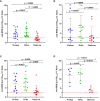SARS-CoV-2 Infection-and mRNA Vaccine-induced Humoral Immunity among Schoolchildren in Hawassa, Ethiopia
- PMID: 37398668
- PMCID: PMC10308774
- DOI: 10.3389/fimmu.2023.1163688
SARS-CoV-2 Infection-and mRNA Vaccine-induced Humoral Immunity among Schoolchildren in Hawassa, Ethiopia
Abstract
Background: With the persisting low vaccination intake, particularly in children of low-and middle-income countries (LMICs), seroepidemiological studies are urgently needed to guide and tailor COVID-19 pandemic response efforts in schools and to put mitigation strategies in place for a future post-pandemic resurgence. However, there is limited data on SARS-CoV-2 infection-induced and vaccine-induced humoral immunity in schoolchildren in LMICs, including Ethiopia.
Methods: As the spike receptor binding domain (RBD) is the major target for neutralization antibodies and useful to predict the correlates of protection, we used an in-house anti-RBD IgG ELISA to assess and compare infection-induced antibody response at two-time points and BNT162b2 (BNT) vaccine-induced antibody response at a one-time point in schoolchildren in Hawassa, Ethiopia. In addition, we measured and compared the levels of binding IgA antibodies to spike RBD of SARS-CoV-2 Wild type, Delta, and Omicron variants in a small subset of unvaccinated and BNT-vaccinated schoolchildren.
Results: When we compare SARS-CoV-2 infection-induced seroprevalences among unvaccinated school children (7-19 years) at the two blood sampling points with a 5-month interval, we observed an over 10% increase, from 51.8% (219/419) in the first week of December 2021 (post-Delta wave) to 67.4% (60/89) by the end of May 2022 (post-Omicron wave). Additionally, we found a significant correlation (p = 0.001) between anti-RBD IgG seropositivity and a history of having COVID-19-like symptoms. Compared to the levels of SARS-CoV-2 infection-induced anti-RBD IgG antibodies before vaccination, higher levels of BNT vaccine-induced anti-RBD IgG antibodies were observed even in SARS-CoV-2 infection-naïve schoolchildren of all age groups (p = 0.0001). Importantly, one dose of the BNT vaccine was shown to be adequate to elicit a strong antibody response in schoolchildren with pre-existing anti-RBD IgG antibodies comparable to that of SARS-CoV-2 infection-naive schoolchildren receiving two doses of BNT vaccine, suggesting a single dose administration of the BNT vaccine could be considered for schoolchildren who had prior SARS-CoV-2 infection when a shortage of vaccine supply is a limiting factor to administer two doses irrespective of their serostatus. Despite the small sample size of study participants, the BNT vaccine is shown to be immunogenic and safe for schoolchildren. Irrespective of schoolchildren's vaccination status, we observed a similar pattern of significantly higher levels of IgA antibodies to Delta-RBD than to Omicron-RBD (p < 0.001) in a randomly selected subset of schoolchildren, yet comparable to Wuhan-RBD, suggesting these schoolchildren were more likely to have had SARS-CoV-2 infection with Delta variant. Additionally, we noted a broader IgA antibody reactivity to SARS-CoV-2 variants in vaccinated schoolchildren with prior SARS-CoV-2 infection, supporting the superiority of hybrid immunity.
Conclusion: Our serological data indicate a significant increase in SARS-CoV-2 seroprevalence in children at a post-Omicron five-month follow-up compared to a post-Delta enrolment. Despite the small sample size of study participants, the BNT vaccine is shown to be immunogenic and safe for schoolchildren. Hybrid immunity would likely provide a broader humoral immunity against Wuhan strain, Delta, and Omicron variants than natural infection or vaccination alone does. However, future longitudinal cohort studies in SARS-CoV-2-naïve and COVID-19-recovered schoolchildren receiving the BNT vaccine are needed for a better understanding of the kinetics, breadth, and durability of BNT vaccine-induced multivariant-cross reactive immunity.
Keywords: BNT162b2 vaccine; COVID-19; RBD; SARS-CoV-2; antibody; dose; schoolchildren; variant.
Copyright © 2023 Merid, Tekleselasie, Tesfaye, Gadisa, Fentahun, Abate, Alemu, Mihret, Mulu and Gelanew.
Conflict of interest statement
The authors declare that the research was conducted in the absence of any commercial or financial relationships that could be construed as a potential conflict of interest.
Figures




References
-
- Viner RM, Mytton OT, Bonell C, Melendez-Torres GJ, Ward J, Hudson L, et al. . Susceptibility to SARS-CoV-2 infection among children and adolescents compared with adults: a systematic review and meta-analysis. JAMA Pediatrics (2021) 175:143–56. doi: 10.1001/jamapediatrics.2020.4573 - DOI - PMC - PubMed
-
- Children and COVID-19: state-level data report. Available at: https://www.aap.org/en/pages/2019-novel-coronavirus-covid-19-infections/... (Accessed 4 Jan 2023).
Publication types
MeSH terms
Substances
Supplementary concepts
LinkOut - more resources
Full Text Sources
Medical
Research Materials
Miscellaneous

